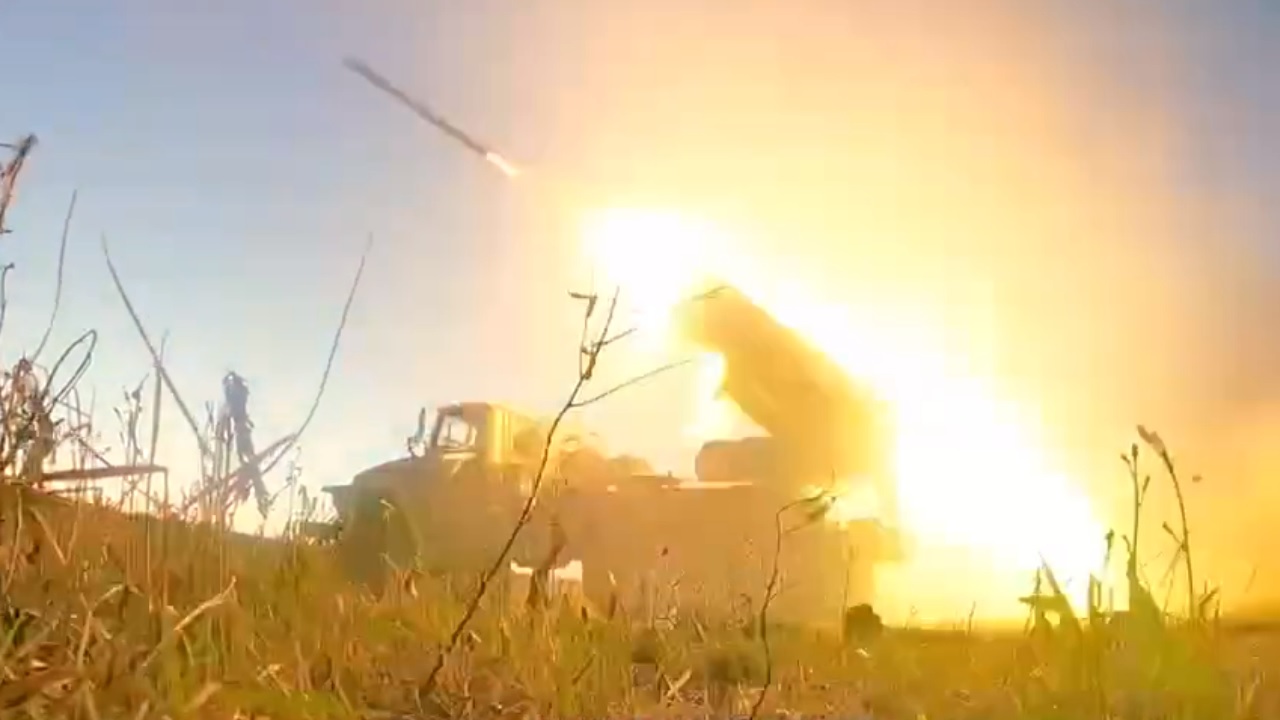Video footage shared online this week appears to show Russian forces once again using incendiary munitions in Ukraine – a widely-condemned weapon that produces heat and is designed to start fires. As we often like to state, 19FortyFive cannot independently verify the footage. However, we have shown this to several prominent experts who state that it does look authentic. But again, we do not claim to have verified the footage.
The video clip, shared on a Russian-language Telegram account, shows the ultra-hot munitions raining down from the sky like fireworks. The video also briefly shows Russian rocket launchers, mounted to the back of a military vehicle, launching the munitions.
“Video of Russian/DNR BM-21 Grad MLRS strikes on Ukrainian positions in the Avdiivka area (posted by a Russian correspondent). It looks like they’re using incendiary munitions,” military analyst Rob Lee writes on Twitter.
The Telegram post that first shared the video included a taunting comment directed at Ukrainian forces, as has become common from both sides.
“Knock knock, Ukrainian tankers near Avdiivka?” the Telegram post reads in Russian, per Google Translate. “Delivery of ‘grads’ from the reactive officers of the 9th Regiment of the DPR and Andrew Filatov.”
Video clips like these are often shared by both the Ukrainian and Russian militaries and are designed to demonstrate the military prowess of each side, help boost confidence among the people of Ukraine or Russia, and intimidate the enemy.
Video of Russian/DNR BM-21 Grad MLRS strikes on Ukrainian positions in the Avdiivka area (posted by a Russian correspondent). It looks like they’re using incendiary munitions.https://t.co/hNyxEGhj4M pic.twitter.com/4ob2x0UwJt
— Rob Lee (@RALee85) July 24, 2022
The first video seen above was reportedly recorded in the Avdiivka region of Donetsk Oblast and comes only days after close-up footage of these weapons was shared online. The footage, recorded from a cell phone in a residential building, shows thermite falling from the sky and landing on lawns, in trees, and on buildings. The munitions, designed to initiate fires, put Donetsk residents in danger.
There are a number of videos showing what looks like incendiary munitions used on Donetsk tonight. https://t.co/uIOorlZ0ydhttps://t.co/8zAfGo7pI1 pic.twitter.com/Pz8JFgxqwm
— Rob Lee (@RALee85) July 23, 2022
Another video showed the incendiary munitions falling from the sky as local people continued to drive their cars on the roads, some likely unaware of what was happening.
Another video. 2/https://t.co/4PhaGoiMTzhttps://t.co/23FUpvbMcMhttps://t.co/4PhaGoiMTz pic.twitter.com/d5ESRMAIF2
— Rob Lee (@RALee85) July 23, 2022
A War Crime to use Such Weapons in Ukraine? Frowned Upon, But Not Banned
While frowned upon by most governments, the use of incendiary weapons is not illegal. Russia’s use of these weapons in Ukraine is not necessarily a violation of international law – however, their use in residential areas could mean Russia is committing war crimes.
As long as Russia can use the excuse that its strikes with incendiary weapons are designed to target as many legitimate military sites and positions as possible, their use is not technically illegal, and a war crime has not been committed.
The Kremlin would also need to prove that precautions were taken to protect civilians and civilian objects, however – and if this footage is anything to go by, making this argument would likely be tough. Civilians recorded the use of incendiary weapons from their cell phones, and video footage shows flammable materials landing on residential buildings and property.
Jack Buckby is a British author, counter-extremism researcher, and journalist based in New York. Reporting on the U.K., Europe, and the U.S., he works to analyze and understand left-wing and right-wing radicalization, and reports on Western governments’ approaches to the pressing issues of today. His books and research papers explore these themes and propose pragmatic solutions to our increasingly polarized society.

